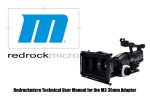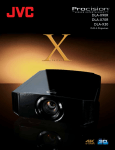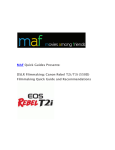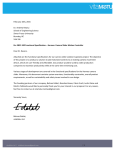Transcript
Kessler KC-Lite Camera Crane For the filmmaker shooting on a tight budget, using a lighter digital video or DSLR camera under 10 pounds, we feel the KC-Lite is the highest quality camera crane / jib in the sub $400 price range. Based off the design of our standard dual-rail KC series of camera cranes, the KC-Lite is a 100% tool-less, single rail crane that is light-weight and portable. Unlike other cranes in this price range, the KC-Lite mounts to your fluid head in a way that utilizes the fluid drag of the head’s pan and tilt giving the best control and fluid like movements. Assembling the Crane 1. Insert a large coupler bar into the crane and secure with a large threaded knob. Do not tighten yet. 2. Slide the crane tip (standard or optional short tip) assembly over the large coupler bar of the base section. 3. Secure with a large threaded knob and tighten both knobs. Note: If you are having trouble aligning the holes when sliding the tip section onto the coupler bar, make sure the knob on the rear section is not tightened all the way. Pull the loose, rear knob towards the front section to make the holes match up on the front side of the coupler bar and tip. Assembling the control Arm 1. Insert a small couple bar into the control arm and secure with a small threaded knob. Do not tighten yet. 2. Slide the other end of the control arm over the small coupler bar. 3. Secure with a small threaded knob and tighten both. Note: If you are having trouble aligning the holes when sliding the tip section onto the coupler bar, make sure the knob on the rear section is not tightened all the way. Pull the loose, rear knob towards the front section to make the holes match up on the front side of the coupler bar and tip. Optional: Vertical Brake When the KC-Lite Crane is not in motion, protect it from unwanted vertical movement with this optional braking system. 1. Gather parts from Vertical Brake kit. 2. Remove the bolt on the end of the control arm closest to the tripod head. Insert the longer bolt, vertical break bar, and nylon washers. Stack the washers so there is no metal on metal contact (see photo). 3. Tighten the bolt and nut with a 7/16” wrench. Use enough tension to remove any play but leave it loose enough to still operate smoothly. 4. Remove the knob on the main crane arm closest to the camera mounting side. Swing the slot in the brake arm up and align it with the hole in the crane. 5. Insert one nylon washer between the brake arm and crane arm to prevent metal on metal rubbing. 6. Put another nylon washer on the large knob supplied with the vertical brake kit and thread the knob all the way through the crane arm. 7. Use the supplied backer knob on the threads protruding through the crane arm. These knobs can now be used to adjust brake tension. NOTE: The brake is to be used when the crane is not being moved vertically. Its purpose is to lock off the vertical position. We do not recommend leaving the crane unattended with the crane using the brake as a resting point. To prevent damage, always lower the crane to the ground when not in use and remove any camera gear. Assembling the Weight Bar 1. Insert the metal weight bar into the receiving hole at the base of the crane. 2. Align the through hole and insert the supplied bolt. 3. Secure with the matching tightening knob. Note: The weight bar now comes preinstalled on all KC-Lite models. Kessler Kwik Release Mounting We recommend using our Kwik Release system with utility plate. This will give you a solid mounting surface while still being able to quick release the KCLite easily. Coupled with our Hercules head and K-Pod system, this is the best mounting solution available. 1. Attach the Kwik Release base to the top of the Hercules head using the two 1/4-20 x 1/2” flat head screws included with the Kwik Release kit. 2. Attach the Kessler Utility Plate to the base of the KC-Lite with two Kessler 1/4-20 thumb screws. 3. Snap the Utility Plate and KC-Lite into the Kessler Kwik Release base 4. Close the rear locking lever. It will snap into place. 5. To remove the KC-Lite from your tripod head, release the locking lever and push the red release pin inward to disengage. Make sure the crane is fully supported before pressing the release lever. Standard Tripod Mounting The KC-Lite is designed to work with most larger tripods. Make sure your tripod is rated to handle the weight of the KC-Lite, camera, and counter weights. 1. Remove the mounting screw(s) from your tripod plate. 2. Insert the two supplied screws through the tripod plate. 3. Attach the tripod plate to the crane using the supplied screws, washers, and wing nuts. 4. Slide the KC-Lite on to your tripod. 5. Securely tighten the quick release on the tripod head. Balancing the crane 1. Mount your camera to the cradle of the crane using the supplied screw. NOTE: Keep the weight under 10 pounds. 2. Balance the crane using weights of your choice using the supplied quick collar to hold them in place. 3. Use the supplied fine tuning weight for exact balancing. Safety Precautions 1) Before using your KC-lite in the field, practice assembly and operation of the unit in a controlled environment such as your studio or warehouse. Please be sure that all those who will be using and operating the crane are present and understand how to use it safely. 2) It is a must to use either a floor spreader or mid level spreader with the tripod when using a Kessler Crane. Using a spreader will strengthen the tripod and increase the level of safety while the crane is in use. 3) Always be sure to rest the camera end of the crane on the ground or other stable surface when adding or removing the counter weights. When assembling the crane mount the camera first, then add the counter weights. When disassembling the crane, remove the counter weights first then remove the camera. 4) lf you are using the optional vertical brake, be sure to never remove any weight from either end of the crane with the brake in a locked configuration. 5) lf using the crane support tripod with the legs extended, be sure that the legs can be locked securely to disallow slippage and that the entire system is still balanced and stable. 6) If using the KC-Lite 5.5 Short Tip with a tripod in its extended configuration, the crane will be too short to reach the ground. Use an elevated surface to rest the camera end of the crane on while setting up and breaking down the crane. This will prevent the crane from possibly tipping over. 7) Please be sure to keep cables and fingers clear of any of the pinch points of the crane. 8) Attempting to move the tripod with the crane and counter weights attached is dangerous unless you are using a dolly. If you are using a dolly, be sure to have the tripod in its lowest configuration as well as using a second operator for added safety. lf you must move the tripod without a dolly, take the time to remove the counter weights and camera first. 9) Never operate the crane over people. 10) Perform an inspection of the crane before each use. Examination should include areas such as; welds for any kind of cracks or fatigue; bolts for proper tightening; support rails for stress; collars should be tight and secure; overall integrity. 11) Never exceed 30 lbs of counter balance weight in any configuration.





